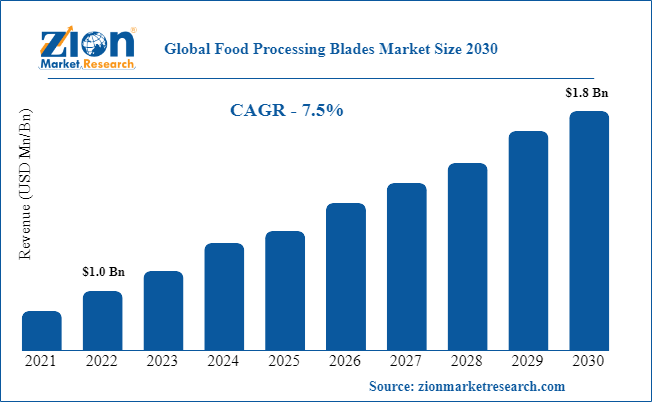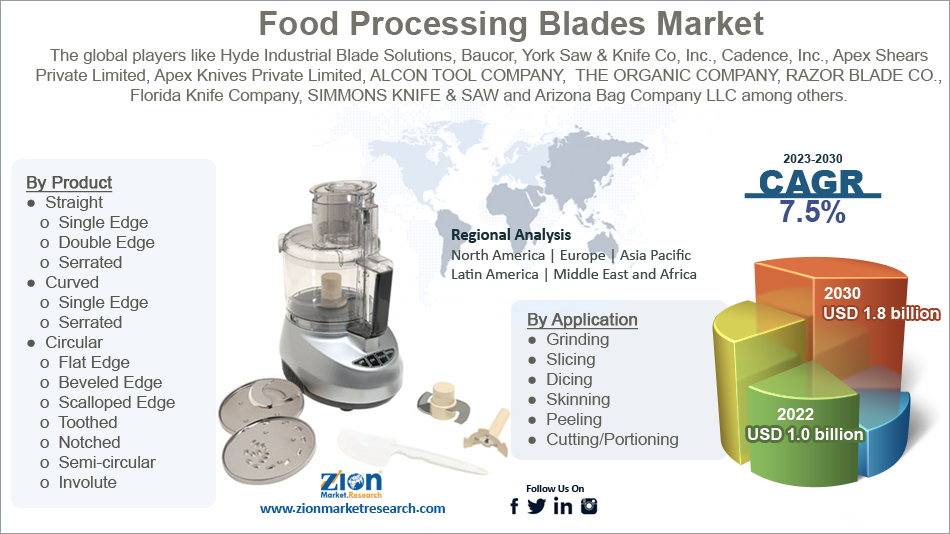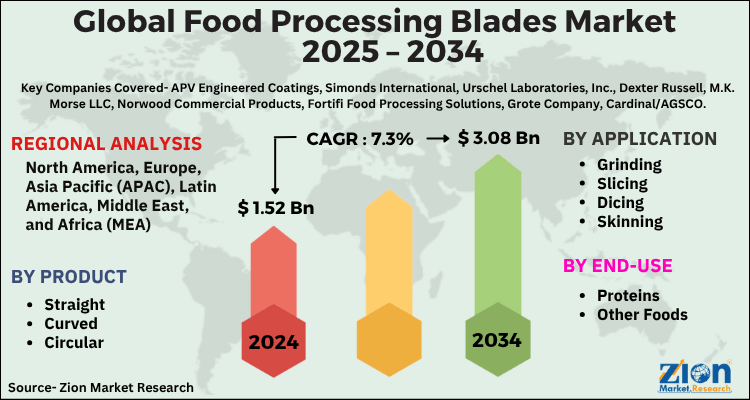Global Food Processing Blades Market Size, Share, Growth Analysis Report - Forecast 2034

Food Processing Blades Market By Product (Straight, Curved, Circular), By Application (Grinding, Slicing, Dicing, Skinning, Peeling, Cutting/Portioning), By End-use (Proteins, Other Foods), and By Region: Global and Regional Industry Overview, Market Intelligence, Comprehensive Analysis, Historical Data, and Forecasts 2025 - 2034
| Market Size in 2024 | Market Forecast in 2034 | CAGR (in %) | Base Year |
|---|---|---|---|
| USD 1.52 Billion | USD 3.08 Billion | 7.3% | 2024 |
Global Food Processing Blades Market: Industry Perspective
The global food processing blades market size was worth around USD 1.52 Billion in 2024 and is predicted to grow to around USD 3.08 Billion by 2034 with a compound annual growth rate (CAGR) of roughly 7.3% between 2025 and 2034. The report analyzes the global food processing blades market's drivers, restraints/challenges, and the effect they have on the demands during the projection period. In addition, the report explores emerging opportunities in the food processing blades industry.
Global Food Processing Blades Market: Overview
A food processor is an appliance used in the kitchen that enables the user to quickly and easily perform monotonous food-making activities like slicing, grinding, chopping, and others. Food processor blades are the equipment’s essential parts that help to process raw material ingredients into food items through chemical and physical procedures. Food processors are available in different categories like slicers, roasters, separators, homogenizers, grinders, fryers, ovens, feeders, chillers, mixers, dryers, and others.
The food processing blades are utilized in various industries including nut, milk, fruit, & chocolate manufacturing unit, the beverage industry, industrial bakeries, the seafood industry, the dairy industry, and poultry farms. Food processor poses various automation control operation systems like drying, freezing, pasteurization, evaporation, cooking, and heating. These blades demand gentle handling and efficient control of pressure and temperature.
Global Food Processing Blades Market: Growth Drivers
Growing consumer demand for processed food drives the market growth
Global consumption of processed foods has rapidly grown in recent decades. The expanding global populace is a significant contributor to this rise. As a result, consumers in urban settings have access to a much broader variety of food options than those in rural settings. This urbanization trend makes a significant contribution to rising living standards and incomes, which in turn have a larger impact on the affordability of processed food products. Thus, this is expected to drive the global food processing blade market growth during the forecast period.
Restraints:
Volatility in the price of raw materials impedes the market growth
Volatility in the price of raw materials is expected to hinder the food processing blade industry expansion during the forecast period as these blades are manufactured in stainless steel. For instance, according to SteelMint, the wholesale price of 2.5-8 mm HRC was Rs 55,250 per tonne as of January 1, 2024; the price increase that went into effect on January 5 raised the wholesale price to Rs 58,000 per tonne.
Opportunities:
Technological advancements are expected to provide a lucrative opportunity
In a variety of industries, there has been an increasing preference for automated food processors, which has led to the gradual phasing out of older models in support of more recent ones. As a consequence, the food processing blade industry has a promising future and the adoption of food processing blades has been facilitated globally. Additionally, ongoing technological development has led to the creation of blades that offer greater accuracy when cutting, slicing, and grinding raw materials, which are becoming more and more well-liked by end users.
Challenges:
The wear and tear properties of the food processing blades pose a major challenge
The wear and tear properties of the food processing blades, which leads to frequent replacements are expected to hinder the food processing blade market growth during the forecast period.
Key Insights
- As per the analysis shared by our research analyst, the global food processing blades market is estimated to grow annually at a CAGR of around 7.3% over the forecast period (2025-2034).
- Regarding revenue, the global food processing blades market size was valued at around USD 1.52 Billion in 2024 and is projected to reach USD 3.08 Billion by 2034.
- The food processing blades market is projected to grow at a significant rate due to increasing demand for processed and packaged foods, the rising adoption of automation in food production, stringent food safety regulations, and continuous advancements in blade materials and design for improved efficiency and hygiene.
- Based on Product, the Straight segment is expected to lead the global market.
- On the basis of Application, the Grinding segment is growing at a high rate and will continue to dominate the global market.
- Based on the End-use, the Proteins segment is projected to swipe the largest market share.
- Based on region, Asia-Pacific is predicted to dominate the global market during the forecast period.
Global Food Processing Blades Market: Report Scope
| Report Attributes | Report Details |
|---|---|
| Report Name | Food Processing Blades Market |
| Market Size in 2024 | USD 1.52 Billion |
| Market Forecast in 2034 | USD 3.08 Billion |
| Growth Rate | CAGR of 7.3% |
| Number of Pages | 212 |
| Key Companies Covered | APV Engineered Coatings, Simonds International, Urschel Laboratories, Inc., Dexter Russell, M.K. Morse LLC, Norwood Commercial Products, Fortifi Food Processing Solutions, Grote Company, Cardinal/AGSCO, Waring Commercial, Wilbur Curtis, Jarvis India, Hallde, Talsabell S.A., and others. |
| Segments Covered | By Product, By Application, By End-use, and By Region |
| Regions Covered | North America, Europe, Asia Pacific (APAC), Latin America, The Middle East and Africa (MEA) |
| Base Year | 2024 |
| Historical Year | 2020 to 2023 |
| Forecast Year | 2025 - 2034 |
| Customization Scope | Avail customized purchase options to meet your exact research needs. Request For Customization |
Global Food Processing Blades Market: Segmentation
The global food processing blades industry is segmented based on product, application, end-use and region. All the segments have been analyzed based on present and future trends and the market is estimated from 2025 to 2034.
Based on the product, the global market is bifurcated into straight, curved, and circular. The circular blade segment is expected to dominate the market over the forecast period. The improvement of the workflow's efficiency and the optimization of the production process is responsible for the segment's development. For the processing industry, circular blades come in a range of designs, including those with beveled edges, smooth edges, notches, teeth, semi-circles, festoons, and involutes. Thus, driving the segment growth during the forecast period.
Based on the application, the market is segmented into grinding, slicing, dicing, skinning, peeling, and cutting/portioning. The grinding segment is expected to account for the largest market share during the forecast period due to its effectiveness in decreasing the food's particle size. Meat, fruits, veggies, and other foods are forced through a grinding plate in the grinding apparatus, which is preceded by a rotating blade. Besides, due to its effectiveness and wide adoption in hotels, restaurants, frozen food suppliers, and other establishments, the cutting/portioning application sector is anticipated to acquire momentum over the forecast period.
By End-use, the global food processing blades market is split into Proteins, Other Foods.
The Regional, this segment includes the current and forecast demand for North America, Europe, Asia Pacific, Latin America,and the Middle East and Africa.
Recent Developments:
- In August 2024, AnyMind Group, an end-to-end business enablement company, together with UUUM, a Japanese multi-channel network and creator management and content marketing leader, announced ARAKA, a direct-to-consumer outdoor brand produced through AnyMind Group. Created by UUUM exclusive creator Tsuriyokadesyou, D2C has released its 6th product collection, a series of high-quality kitchen knives made in Tsubame-Sanjo, Niigata Prefecture, as well as cutting boards made of high-tech wood and rubber materials in Japan.
- In June 2024, to increase the yield and quality of beef and poultry products without halting production, GEA introduced a new high-performance system. Especially for lean cuts of meat that are prone to drying out during cooking, the MultiJector is an automated brine injection system that will make it simpler for food processors and produce a juicier and more flavorful finished meal. The most recent model from the company uses a method called maximum "time-in-meat," which means that the needles stay in the product longer during the injection. This improves brine uptake and evens out distribution, which has a significant positive impact on quality, efficiency, and yield.
Global Food Processing Blades Market: Regional Analysis
The food processing blades market demonstrates varied growth across regions, driven by local industry dynamics and evolving consumer preferences. North America and Europe hold significant shares due to established food processing industries, technological advancements, and stringent food safety regulations, fostering demand for high-precision, hygienic blades. Meanwhile, the Asia-Pacific region is witnessing rapid growth, fueled by rising disposable incomes, urbanization, and expanding processed food consumption, especially in countries like China and India. Latin America and the Middle East & Africa are gradually emerging markets, supported by growing investments in food production infrastructure and increasing adoption of modern food processing techniques. Overall, regional trends reflect a balance of mature markets prioritizing innovation and efficiency, and developing regions focused on scaling up production to meet rising food demand.
Global Food Processing Blades Market: Competitive Analysis
The report provides a company market share analysis to give a broader overview of the key market players. In addition, the report also covers key strategic developments of the market, including acquisitions & mergers, new product launches, agreements, partnerships, collaborations & joint ventures, research & development, and regional expansion of major participants involved in the food processing blades market on a global and regional basis.
The global food processing blades market is dominated by players like:
- APV Engineered Coatings
- Simonds International
- Urschel Laboratories Inc.
- Dexter Russell
- M.K. Morse LLC
- Norwood Commercial Products
- Fortifi Food Processing Solutions
- Grote Company
- Cardinal/AGSCO
- Waring Commercial
- Wilbur Curtis
- Jarvis India
- Hallde
- Talsabell S.A.
Global Food Processing Blades Market: Competitive Analysis
The global food processing blades market is segmented as follows;
By Product
- Straight
- Curved
- Circular
By Application
- Grinding
- Slicing
- Dicing
- Skinning
- Peeling
- Cutting/Portioning
By End-use
- Proteins
- Other Foods
Global Food Processing Blades Market: Competitive Analysis
- North America
- The U.S.
- Canada
- Mexico
- Europe
- France
- The UK
- Spain
- Germany
- Italy
- Rest of Europe
- Asia Pacific
- China
- Japan
- India
- Australia
- South Korea
- Rest of Asia Pacific
- The Middle East & Africa
- Saudi Arabia
- UAE
- Egypt
- Kuwait
- South Africa
- Rest of the Middle East & Africa
- Latin America
- Brazil
- Argentina
- Rest of Latin America
Table Of Content
Methodology
FrequentlyAsked Questions
A food processor is an appliance used in the kitchen that enables the user to quickly and easily perform monotonous food-making activities like slicing, grinding, chopping, and others. Food processor blades are the equipment’s essential parts that help to process raw material ingredients into food items through chemical and physical procedures. Food processors are available in different categories like slicers, roasters, separators, homogenizers, grinders, fryers, ovens, feeders, chillers, mixers, dryers, and others.
The global food processing blades market is expected to grow due to rising demand for processed food, increasing automation in food production, stringent hygiene and safety standards, and advancements in durable and high-performance blade materials.
According to a study, the global food processing blades market size was worth around USD 1.52 Billion in 2024 and is expected to reach USD 3.08 Billion by 2034.
The global food processing blades market is expected to grow at a CAGR of 7.3% during the forecast period.
Asia-Pacific is expected to dominate the food processing blades market over the forecast period.
Leading players in the global food processing blades market include APV Engineered Coatings, Simonds International, Urschel Laboratories, Inc., Dexter Russell, M.K. Morse LLC, Norwood Commercial Products, Fortifi Food Processing Solutions, Grote Company, Cardinal/AGSCO, Waring Commercial, Wilbur Curtis, Jarvis India, Hallde, Talsabell S.A., among others.
The report explores crucial aspects of the food processing blades market, including a detailed discussion of existing growth factors and restraints, while also examining future growth opportunities and challenges that impact the market.
HappyClients
Zion Market Research
Tel: +1 (302) 444-0166
USA/Canada Toll Free No.+1 (855) 465-4651
3rd Floor,
Mrunal Paradise, Opp Maharaja Hotel,
Pimple Gurav, Pune 411061,
Maharashtra, India
Phone No +91 7768 006 007, +91 7768 006 008
US OFFICE NO +1 (302) 444-0166
US/CAN TOLL FREE +1 (855) 465-4651
Email: sales@zionmarketresearch.com
We have secured system to process your transaction.
Our support available to help you 24 hours a day, five days a week.
Monday - Friday: 9AM - 6PM
Saturday - Sunday: Closed







